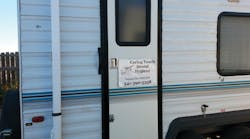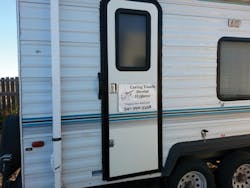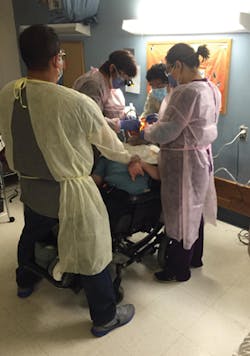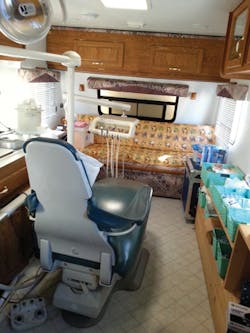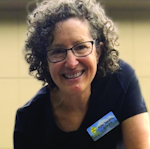Have need will travel: Independent hygienists answer calls for unique dental services
Although some might debate whether all people have a right to health care regardless of finances, too many people do not have access to basic dental care; in fact, more than 46 million people are unable to get the care they need.1 Many children do not have access to preventive dental care, resulting in unnecessary pain, missed school days, and increased costs. In fact, dental decay is the single most common chronic childhood disease, and it is entirely preventable! This is unconscionable.
Ten million Americans have an intellectual and developmental disability (I/DD), and many of them do not have access to professional dental hygiene services.2 The number of people older than 65 is growing, and at least 1.5 million now live in some sort of long-term care residence.3 Many people who cannot access basic dental care experience needless pain and are more likely to experience poor health outcomes that are largely preventable, unnecessarily increasing health-care costs.
In Oregon during 2010, there were 28,000 emergency room visits for nontraumatic dental pain (NTDP) at a cost of $8 million.3 In the United States during 2009, there were 830,000 emergency room visits for NTDP.2 In Iowa during 2007, emergency room visits for NTDP cost $5 million. The 2010 costs in Florida totaled $88 million, and in 2000, adults lost 164 million hours of work and children missed 51 million hours of school due to NTDP.2
Obviously, we have a problem in the United States! In Oregon during 2010, 25% of patients who went to an emergency room for NTDP made a repeat visit for the same problem.3 Because emergency room doctors are unable to do more than prescribe pain medications and antibiotics for NTDP-and unless patients are connected with a dental home-acute pain will continue and so will visits to the emergency room. The cost for a visit to the emergency room was $294 In Oregon during 2010. In comparison, the cost to provide basic dental insurance for one person for one year was $228.3
Out in the community
With many people making multiple visits to the emergency room, it is apparent that not only are we not getting to the root of the problem, but it is also costing a lot more money by continuing in this manner. Imagine the possibilities if more people had access to preventive dental hygiene services by having more dental hygienists out in the community. The possibilities are limitless.
We are currently increasing access, but not nearly at the rate needed to make a dent in this epidemic. The first state to allow dental hygienists to see patients outside of a traditional dental setting and without the supervision of a dentist was Washington in 1984,2 followed by Colorado in 1987, New Hampshire in 1993, California and Nevada in 1998, and Connecticut and New Mexico in 1999.2 In total, 37 states now have some sort of law that allows dental hygienists to provide dental hygiene care in alternative settings.1
With more states and more hygienists being utilized outside of the traditional setting, we should be able to decrease costs to hospitals and the government, as well as to patients from loss of work due to pain. Many dental hygienists would love to see patients in alternative settings. However, for many, the prospect seems daunting in setting up a business and finding funding, not to mention the lack of support for these endeavors.
There are many benefits to being a mobile and independent dental hygienist, and increasing access to care is one of the greatest outcomes. There are many different ways to practice that allow for a dental hygienist to be creative when choosing this route.
Community clinic
Virginia Olea, RDHEP (registered dental hygienist in expanded practice), is from central Oregon and has experienced this firsthand. When Virginia graduated from dental hygiene school in 2008, she started working part-time in a general dental office, at a clinic, and volunteered on a mobile dental van, primarily numbing patients prior to extractions.
At the clinic, most patients had not been seen in more than 10 years, and the time allotted per patient was not enough to deal with the advanced periodontal disease. In private practice, many patients needed nonsurgical periodontal treatment, but due to exorbitant fees, they did not return for treatment.
Virginia was frustrated at not being able to offer ongoing preventive services at affordable fees. She knew that was what patients needed to help prevent further periodontal destruction. She wanted to make more of an impact on their health.
In January 2012, the Oregon Practice Act was amended to add those people who are at 200% of the federal poverty level as populations that could be seen by and treated by expanded practice dental hygienists. This was the turning point for Virginia, and she started researching how to deliver dental hygiene care as an independent practitioner.
Originally published in 2016 and updated regularly
Never in her wildest dreams did she imagine that she would be able to buy a motor home. But in 2012, she bought a 19-foot travel trailer, pulled out the dinette, and installed a used dental unit complete with chair from a government bidding website (governmentliquidations.com).
Virginia now parks her trailer in the parking lot at Mosaic Medical in Central Oregon-a federally funded medical clinic. They schedule patients for her, and she does not have to deal with filing insurance claims. She also sees low-income patients from the Latino community in Bend, Madras, and Redmond through the Latino Community Association. She spends as much time as she needs with each patient and does not charge exorbitant fees. So the patients come back to see her for maintenance.
It did not take long for patients to see the value in what she does. Virginia also contracts with the state's school sealant program to apply sealants 85 to 90 days each school year.
In addition, every three months, Virginia drives her trailer and all her equipment to Christmas Valley where she hosts a three-day clinic and provides care for seniors, migrant workers, and veterans. She has seen a total of 565 patients; 190 have come back to see her multiple times, and 56 of those patients had been going to a dental office and stopped upon losing insurance and/or not being able to pay the rising fees. The average age of her patients is 38.
She loves being her own boss and being able to offer affordable dental hygiene services to her community.
Of course, there are a few downsides to being mobile and having your own business. It takes more time to set up and put things away. According to Virginia, though, it is well worth it because she knows she is making a difference. Other downsides are the startup costs. The population group that the dental hygienist chooses to care for often will dictate some of the supplies needed.
"For a while, I was taking care of the Latino/Hispanic population in a church and decided it would be best to have a mobile unit that included a handpiece, an air/water syringe, and suction," she said. "For those working with the elderly, those in acute care, or some I/DD, having a mobile unit might not be necessary or recommended. Starting out small and not spending a lot of money can be more doable when there are so many other things to think about at the onset."
She offers advice for those hygienists interested in making the leap. She recommends having a conversation with organizations that work with the target population you are interested in treating. Don't get discouraged if you get no response, or if it is negative; keep persevering.
Virginia can be reached at [email protected] and her mobile business is called Caring Touch Dental Hygiene. As a side note, her husband makes portable units for dental hygienists. His business is called Dental Dolly.
Some mobile dental hygienists love working with the elderly and those with declining memory. Many live in long-term care facilities (LTC). Those living in LTCs are generally unable to access dental care, and this population group is three times more likely to acquire aspiration pneumonia, the second most common infection at an LTC and a leading cause of hospital admissions and subsequent death.5 Access to preventive services would lower the risk of aspiration pneumonia in this population. 6,7
Caring for the elderly
Like Virginia, Shirley Smith, a registered dental hygienist in expanded practice in California, worked in a mobile dental van and in a private practice early in her career. Shirley was motivated to go out on her own because she did not feel appreciated for her hard work. She wanted more satisfaction out of her career. She loves being her own boss, being independent, and making her own hours.
Shirley takes care of patients from any population group but especially loves taking care of seniors, especially those with Alzheimer's or dementia, and she loves making a difference in their lives and the challenge it brings. Shirley has a lot of compassion, and the families of her clients recognize this. They have told her that is what sets her apart from other health-care providers.
Shirley works four to five days each week and sees five to eight patients a day. Frequently, her patients are moving around while she treats them. Sometimes she tries to provide dental hygiene care while they are walking around. Some of her Alzheimer's clients are on medications that agitate them, and they can't stop walking.
"I often walk backwards and scale ... until I back into a wall," she said. This certainly makes her day interesting and always unpredictable.
With her own business, Shirley knows she is appreciated and her patients look forward to their visits with her. Sad as it seems, she is often their only visitor. One of the most difficult aspects of her work is when one of her patients dies. Recently, one died in her arms after saying, "I'm dying. You made me smile, and you are the last person to see me smile and make me laugh."
Shirley knows that she is not only providing preventive dental hygiene care, but is making a difference in people's lives. Her setup is different than Virginia's, as she has all of her supplies in a box, making it easy to transport. Although Shirley owns a mobile unit, she uses it with the general population but not with those with Alzheimer's or dementia. Shirley provides care wherever she finds her clients as long as there is privacy. It might be from their bed, a chair, or even the commode seat!
In the past, when she tried to polish, many patients would bite the handpiece, and most were scared of the noise. So with her patients with dementia, she does not polish their teeth. She always brushes their teeth with chlorhexidine before scaling, leaves that new toothbrush with them, and then throws out the old one and applies fluoride varnish at the end of the appointment.
There have been some drawbacks for Shirley as nursing home corporations are taking away some of her patients. As a small business, she cannot compete with them. The corporations have not taken the time to get to know her. They have hired their own dental hygienists who must treat the patients in shortened appointments in order to see more patients. Shirley's concern is that the patients will not get the best treatment with fewer checks and balances.
Caring for the developmentally disabled
In addition to the elderly, children, and the poor, people with intellectual or developmental disabilities (I/DD) are at increased risk for dental disease. In order of unmet needs, lack of access to regular dental care is third on the list, thereby increasing the chance of poor overall health.4 Generally, those with I/DD have a greater incidence of malocclusion, mouth breathing, hyposalivation, poor oral hygiene, poor motor skills, take more medications, and, because they are intellectually challenged, they are more likely to not understand or remember instructions.4 This results in higher incidences of decay, periodontal disease, missing teeth, poor health outcomes, and higher costs.
There is also bias against patients with I/DD due to lack of knowledge, fear, and little to no education for many professionals who work with or make decisions for this population group.4 Many people with I/DD do well in a dental office. But for most, being out of their normal surroundings can be difficult for them, likely increasing the chances of stress and uncooperative behavior. In addition, many people with I/DD do not have insurance or have government insurance that is not accepted at many dental offices. This makes it difficult for the majority to receive preventive oral health care.
Dee Olsen, RDHAP, from California, loves treating this population and splits most of her time between seeing those with I/DD and elders in memory care, skilled nursing, and a small percentage who are homebound. Like Virginia and Shirley, she started her career in private dentistry and was intrigued by two colleagues who were part of the original Health Manpower Pilot Project (HMPP) in California from 1987-1990. The pilot project was started as a way to evaluate if expanding the practice of dental hygienists outside of traditional settings would increase access to care. The results demonstrated that fees were lower than in traditional dental offices and people on Medicaid were treated more often.5
Dee said, "I was inspired by Charlotte Burruso, RDHAP, and Marilyn Blackmon, RDHAP, who practiced together under the project in the Southern California area."
Dee wanted to increase access to care for bedridden residents who needed care and were not getting it. This was especially apparent after seeing her former employer in a convalescent hospital where she noticed he was not receiving any oral health care.
Dee earned her RHDAP degree in 2007. In 2008, she participated in a project that was funded with a grant through LA Care. She taught staff at an intermediate care facility for the developmentally disabled about oral care, acids, decay, xylitol, bacteria, oral hygiene, and overall health. She used videos, taught them how to brush the teeth, and apply fluoride varnish.
The grant lasted for two years. By the end of the project, there was a decrease in the amount of pneumonia and the number of hospital visits. After it ended, Dee contracted with the facility and now sees clients every three months for periodontal maintenance visits. The dentist who examines these patients has noticed an overall increase in health.
Dee is also involved in another project at a Southern California Regional Center where she and two other RDHAPs provide dental hygiene services for I/DD clients. These patients also receive an annual visit from a local dentist, and this project is in its fifth year. At the subacute hospitals, many patients are on feeding tubes and ventilators. These patients are very susceptible to aspiration pneumonia because bacteria travel more easily from the upper airway to the lungs.6 Dee provides annual hands-on training of staff at all of the facilities where she works.
She has a portable unit with suction, a piezo, a separate suction unit she can use when she does not use her portable unit, hand scalers, and, of course, all of the disposables. Dee does not use the portable unit on all of the patients. Much is dependent on their specific needs and whether the patient can tolerate the noise. At the subacute hospitals, patients with ventilators and feeding tubes have suction units available.
She said that being an RDHAP and her own boss has been one of the best decisions she has ever made. But she said it can be tough at times. There are long hours when she pounds the pavement to get patients, writes letters, sends faxes, does cold calling, schedules, and does all of the billing. She gets paid through private patient payments, Denti-Cal, some insurance, special projects, and she also provides some pro bono care. She says that it can be frustrating when the staff at the facilities do not follow through with regular oral care. This often occurs due to a high turnover rate of staff.
Being a dental hygienist who can go into untraditional settings can be enjoyable, rewarding, and help alleviate the access-to-care problem we have in the United States. There are many different ways to make this happen. For those dental hygienists who are interested, find out if your state has expanded practice laws that will allow you to go into untraditional settings. Start small and let's all see what we can do to increase our access issues. RDH
Kyle Isaacs, RDHEP, BHS, lives near Corvallis, Oregon, where she works four days a week in a dental office. She also owns a company, Miles 2 Smiles LLC, and provides dental hygiene care in churches, private homes, and schools. Eventually, she hopes to provide care in nursing homes as well. She is a member of the American Dental Hygienists' Association and serves on the board of her local component. She loves to volunteer and comes from a family with many dental professionals. She has been a dental hygienist for 32 years.
References
1. Transforming Dental Hygiene Education and the Profession for the 21st Century. American Dental Hygienists' Association. 2015.
2. Sanders B. 2012. Dental Crisis in America, The Need to Expand Access. A report from Chairman Bernard Sanders. Subcommittee on Health, Education, Labor & Pensions. February 29, 2012.
3. Sun B, Chi DL. 2014. Emergency Department Visits for Nontraumatic Dental Problems in Oregon State. Oregon Health & Science University and University of Washington.
4. Fisher K. 2012. Is There Anything to Smile About? A Review of Oral Care for Individuals with Intellectual and Developmental Disabilities. Nursing Research and Practice. Volume 2012 (2012), Article ID 860692. http://dx.doi.org/10.1155/2012/860692.
5. Kushman J, Perry D, Freed J. 1996. Practice Characteristics of Dental Hygienists Operating Independently of Dentist Supervision. Journal of Dental Hygiene.
6. Scannapieco FA, Shay K. 2014. Oral Health Disparities in Older Adults: Oral Bacteria, Inflammation, and Aspiration Pneumonia. Dental Clinics of North America.
7. Terpenning M. 2005. Geriatric Oral Health and Pneumonia Risk. Clinical Infectious Diseases. Vol. 40, issue 12.
8. Direct Access States. ADHA.org, 2015
9. Liantonio J, Salzman B, Snyderman D. 2014. Preventing Aspiration Pneumonia by Addressing Three Key Risk Factors: Dysphagia, Poor Oral Hygiene, and Medication Use. Annals of Long-Term Care, Clinical Care and Aging. vol. 22, issue 10.
